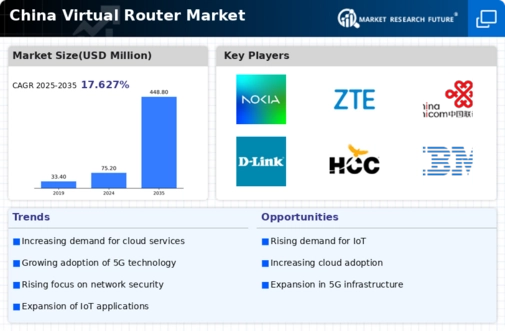Emergence of 5G Technology
The rollout of 5G technology in China is poised to revolutionize the virtual router market. With its promise of ultra-fast data speeds and low latency, 5G creates new opportunities for virtual routers to enhance network performance. As telecommunications companies invest heavily in 5G infrastructure, the demand for advanced networking solutions, including virtual routers, is expected to rise. The virtual router market may experience substantial growth as businesses leverage 5G capabilities to support applications such as IoT, augmented reality, and smart manufacturing. Moreover, the integration of virtual routers with 5G networks can facilitate more efficient traffic management and resource allocation, further driving their adoption across various sectors.
Increased Focus on Cost Efficiency
Cost efficiency remains a critical driver for the virtual router market in China. As businesses strive to optimize their operational expenditures, the adoption of virtual routers presents a viable solution. These routers typically require lower capital investment compared to traditional hardware routers, making them an attractive option for enterprises looking to reduce costs. The virtual router market is likely to see growth as organizations recognize the long-term savings associated with virtualized networking solutions. Furthermore, the ability to scale resources dynamically allows companies to adapt to changing demands without incurring significant expenses. This focus on cost efficiency is particularly relevant in the current economic climate, where businesses are increasingly scrutinizing their IT budgets.
Rising Demand for High-Speed Internet
The virtual router market in China experiences a notable surge in demand for high-speed internet services. As urbanization accelerates, more households and businesses seek reliable and fast connectivity. This trend is further fueled by the increasing number of internet users, which reached approximately 1 billion in 2025. Consequently, service providers are compelled to invest in advanced networking solutions, including virtual routers, to meet consumer expectations. The virtual router market is likely to benefit from this growing demand, as these routers facilitate efficient bandwidth management and enhance overall network performance. Moreover, the Chinese government's initiatives to improve digital infrastructure may further stimulate market growth, as they aim to provide high-speed internet access to rural areas, thereby expanding the customer base for virtual routers.
Shift Towards Virtualization in Networking
The transition towards virtualization in networking is a pivotal driver for the virtual router market in China. Organizations are increasingly adopting virtualized solutions to enhance flexibility and reduce operational costs. Virtual routers, which allow for the separation of hardware and software, enable businesses to deploy networking functions without the need for extensive physical infrastructure. This shift is particularly relevant in sectors such as telecommunications and cloud computing, where agility and scalability are paramount. The virtual router market is poised to capitalize on this trend, as companies seek to streamline their operations and improve service delivery. Furthermore, the growing emphasis on software-defined networking (SDN) aligns with this virtualization trend, potentially leading to increased investments in virtual router technologies.
Government Initiatives for Digital Transformation
The Chinese government's commitment to digital transformation serves as a significant catalyst for the virtual router market. Initiatives aimed at enhancing the country's digital economy, such as the 'Digital China' strategy, promote the adoption of advanced networking technologies. By 2025, the government aims to increase the contribution of the digital economy to GDP to over 30%. This ambitious goal necessitates robust networking solutions, including virtual routers, to support the burgeoning digital infrastructure. The virtual router market stands to gain from these initiatives, as they encourage investments in modern networking capabilities. Additionally, the government's focus on smart city projects and IoT applications further underscores the need for efficient and scalable networking solutions, thereby driving demand for virtual routers.


























Leave a Comment